Nearly a year after Braeden Bradforth’s death following his first day of junior college practice, his family is still dealing with the loss of its “gentle giant.” Meanwhile, his mother has fought for answers about the day she lost a son, not knowing how hard that fight would be.
NEPTUNE, N.J — Braeden Bradforth called home on his first day at junior college in high spirits, gushing about meeting a fellow student who looked just like him, down to the dreadlocks. After his last-minute acceptance to play football at Garden City Community College (GCCC), Bradforth had begun the process of getting accustomed to life in western Kansas, making friends by playing video games in his dorm. The 6’4″, 300-pound defensive lineman was happy to hear that the care package his mother Joanne Atkins-Ingram was putting together back in New Jersey included Golden Oreos, gum and Oodles of Noodles.
On Aug. 1, as his third day on campus settled into a humid, 84° evening, Bradforth went to a conditioning test on GCCC’s first day of preseason practice. Players were expected to complete 36 sprints of 50 yards at speeds that varied by position group. To two coaches and one trainer looking on, nothing seemed off about how Bradforth completed the drill, but as players moved from the field to a team meeting, the freshman wandered off, hardly acknowledging a coach who called out to him. Less than an hour after practice ended, he was found lying barely conscious with his head against a brick wall in an alley near the dorms. A coach said Bradforth was moaning when he arrived at the scene, and he began to choke and vomit as he was moved to an ambulance. About two hours after practice had ended, Bradforth was pronounced dead at St. Catherine Hospital.
What happened from the start of that workout until the end of Bradforth’s life? His grieving mother thought it was a reasonable question, but it proved to be extremely difficult to answer as the days turned into months and a school halfway across the country that appeared to be a lifeline for his college football career instead became a source of conflicting stories and an obstacle to his family’s search for answers.
Head coach Jeff Sims initially told the media that Bradforth had likely died from a blood clotting disorder, but months later, an autopsy found the cause of death to be exertional heat stroke. As Atkins-Ingram dug deeper, players told her they had had no water breaks during that conditioning test, that Bradforth was struggling and that Sims taunted Bradforth during the workout that pushed him to heat stroke.
In December, a notice of claim was filed on her behalf that named coaches, the school, two juco football governing bodies and several other parties as possible defendants in a wrongful death lawsuit. The school conducted an internal review of the circumstances that led to Bradforth’s death but elected not to release its findings in full. Only on April 18, eight and a half months after Bradforth’s death, did the family receive a summary of the review—which Atkins-Ingram called “full of crap”—that provided a basic timeline of what happened but was silent on crucial controversial details. GCCC’s lawyer notified the family that no “formal report” laying out the entirety of the review’s findings was forthcoming.
In May, GCCC retained outside counsel for the purpose of conducting an independent, external investigation, with the help of Dr. Rod Walters, whose firm was hired last summer by the University of Maryland to conduct a similar safety review into the case of Jordan McNair after the second-year offensive lineman died in the hospital days after collapsing at a May 2018 workout. Walters’s team found that the Maryland training staff did not follow protocol in treating McNair’s symptoms, revelations that led to the resignation (under pressure from the school) of head strength and conditioning coach Rick Court, and the firing of Terps head coach D.J. Durkin.
Atkins-Ingram doesn’t understand why McNair’s death generated so much attention while her son’s did not. With the one-year anniversary of McNair’s death on June 13 and Braeden’s approaching fast, another summer season is upon thousands of football players, coaches, athletic programs and parents across the country. Atkins-Ingram wants to make sure no other parent has to endure the tremendous loss she suffered, or replicate the campaign she launched to get answers from a school that gave her few until nearly 10 months after her son’s death.
“What’s so disgusting is the fact that every bit of information that we have gotten, we’ve had to fight for it,” Atkins-Ingram says. “It just didn’t come naturally. Like, if there wasn’t a problem, it should just be able to roll off your tongue.”
According to the school’s internal review, present along with Sims at the practice were nine other football coaches, head athletic trainer TJ Horton, eight student helpers and three certified trainers. Horton reported in the summary that there were 60 gallons of water on site, and student helpers had water bottles in their carriers. Yet those resources seem to belie the conditions under which Bradforth and his teammates completed their workout.
Five players told SI there was barely a break between each sprint, even though the summary says they were allowed 30 seconds of rest. Six players said that players were not allowed to drink water until the end of the workout and that anyone who stopped running would need to redo the entire workout the next morning. A Garden City spokesperson said water was “readily available” for players during practice, and former defensive line coach Ben Bradley said water was available during the sprints, but since he was busy helping run the drill, he couldn’t confirm whether players were drinking. The coroner’s report, citing GCCC coaches and trainers, states that Bradforth “participated without issue in football practice and was behaving normally.”
After practice ended at approximately 9:05 p.m., safeties coach Caleb Young noticed Bradforth stumbling before regaining his balance as he was trying to speed up within the final group of players walking off the field. In an email sent to school administrators on Aug. 31, 2018 and obtained by the Associated Press through an open records request, Young said he told Bradforth, “Hey, you’re good. Let’s go,” to which Bradforth responded, “Yeah, I’m good. I’m good.” But instead of following the group to a team meeting, Bradforth broke away from the group, leading Young to ask him if he was quitting the team. “He did not respond with words, instead, he shook his head in what looked like to me disappointment and continued to walk away,” Young wrote.
Bradforth was found at around 9:45 p.m., after the team meeting broke up. The EMS report states one coach turned a hose on Bradforth to “see if they could get him to respond and he would not so that is when they contacted EMS.” According to the same report, when emergency personnel arrived, several coaches were around Bradforth, and he was wet and moaning. Young wrote to administrators that he ran to the area where Bradforth was when he was alerted a player was down, and that Bradforth was in “visible distress at this time however still breathing and making a stressful moan.” Instead of immediately calling 911, Young wrote that he called Sims in search of guidance, and the head coach directed him to call the trainer. Young adds that while he was on the phone, “a few of the players were assisting with filling their water jugs and bottles with water from the drinking fountains as we attempted to pour it over him and to get him to drink it.”
Horton had left campus and needed to be called back by the coaches. Horton returned to campus at 9:53 p.m. and was the one to call 911 at 10 p.m. (However, Young wrote in his letter to school officials that he was the one who called 911.) An ambulance reached Bradforth within 10 minutes and arrived back at the hospital at 10:33 p.m. after coaches helped move Bradforth to the ambulance from the alley. Young wrote that as EMTs put him on a stretcher to get to the ambulance, he noticed Bradforth “begin to choke; he then opened his eyes and threw up what looked like dirty motor oil.” Bradforth was pronounced dead at 11:06 p.m. GCCC did not answer follow-up questions about why it took 15 minutes for those who had found Bradforth to call 911, or why 911 was not immediately called if the lead trainer was away from campus.
Sims, who is now the head coach at Missouri Southern State University, told Sports Illustrated two days later that an emergency room doctor had told him a test was indicative of a blood clot that had broken free and caused a heart attack. Sims told SI it was “something that could have happened anytime or anywhere.”
Back on the East Coast, around 1 a.m., Atkins-Ingram got an incoherent, tearful phone call from her other son, Bryce Bradforth. She couldn’t understand what he was saying, so she called her husband Robert Ingram Jr., Braeden’s stepfather. Taking time to find the right words, Ingram Jr. called Atkins-Ingram back and told her that Braeden was gone. All she could do was let out a scream. After that, everything went black.
ince that day, Atkins-Ingram has fought to learn why the place that was entrusted with caring for her son failed to do so. Excluding a conversation with school president Ryan Ruda, campus police chief Rodney Dozier and interim athletic director Colin Lamb before the completion of her son’s autopsy, Atkins-Ingram says not one coach has reached out to her. After a few weeks, Atkins-Ingram recruited her longtime friend Jill Greene, a lawyer, to help her find out more about Bradforth’s death.
When Atkins-Ingram heard the results of the autopsy, she became frustrated with Sims’s private and public handling of Bradforth’s death as something that could have happened at any time. “That act-of-God business, God has him now,” she says. “But you kind of helped push him there.”
After months of getting nowhere with the school, Atkins-Ingram and Greene took a trip to Garden City in January. There, they spoke with players, trying to learn more about the practice and Bradforth’s final moments. What they discovered disturbed Atkins-Ingram.
In the internal summary, Sims and Horton said Bradforth didn’t complain or drop a knee to the ground during the test, and Bradley told SI he “dominated,” but six players told SI that Bradforth struggled while completing his sprints. Donte Morris, a former Garden City player serving as an unpaid assistant while he finished his classes, told SI that Bradforth seemed short of breath and was wheezing. Defensive lineman Olajuwon Lewis, who said he ran with Bradforth, recalled his white lips and dry mouth: “It was something you’re never going to forget.” Still, Bradforth kept running.
“You couldn’t drink water during running ’cause Sims said and a lot of other coaches said that water during workouts does nothing for you,” defensive back Kirby Grigsby told SI. “It’s how you hydrate before and after. That’s basically their motto about that kind of thing.” When asked about this interpretation of team policy, Bradley said coaches wouldn’t tell kids not to drink water. Morris told SI that although Sims preached the importance of hydration to his players, due to the pace of this particular conditioning drill players didn’t receive water unless they dropped out entirely. When reached for comment, Sims told SI he wasn’t allowed to speak on the matter and instead referred questions to lawyers.
Players also said Sims taunted Bradforth during the practice. According to Bradley, Sims had given Bradforth a loaner pair of shoes to use, and wide receiver CJ Anthony heard Sims yell that he wanted his shoes back, which Anthony took as a motivational tactic to make Bradforth run faster. Three players recalled Sims telling them he spoke with Braeden’s biological father Sean Bradforth, who does not live with Atkins-Ingram and was in and out of Braeden’s teenage life. One player remembers Sims mentioning that Sean Bradforth had told Sims that Braeden was a hard worker in practice. (Sean Bradforth confirmed to SI that he had recently called Sims.) One player said Sims “was up in Bradforth’s face” while running and that he was a “hard-nosed coach,” but that’s how he was with all of his players. Other players corroborated this, saying Sims cussed Bradforth out and screamed at him. Bradley denies this, saying Sims is a “good coach,” though he conceded Sims’s “competitiveness makes him out to be crazy because he’s willing to do whatever.” The school’s summary made no note of any comments made by Sims during practice.
What Bradforth did after walking away from his teammates after practice remains a mystery to his family. The summary of Garden City’s internal report and Young’s letter to his superiors offered no answers on those missing minutes.
Young, who did not return calls made to him for this story, appears to have been the first coach at the scene, according to the internal report summary and his letter to administrators. The few players present had trouble remembering who else was there because it was only the first day of conditioning. Among those present, there appears to have been confusion about how best to immediately help Bradforth. Bradley said he got there after someone had already poured water on Bradforth, and he wasn’t sure what was going on: “I didn’t know he was overheated. I thought he was passed out.” Morris said a trainer poured water on Bradforth. Grigsby said he was asked if he had any water when he arrived, then poured some on Bradforth because he thought he might have been dehydrated. Grigsby says he left after Young assured him that Bradforth would be O.K.
Soon the ambulance came, and Bradley rode with Bradforth to the hospital. In their timelines, school and medical records don’t make any note of Bradforth’s rectal temperature having been taken, a measure the National Athletic Trainers’ Association lists prominently in its instructions for assessing exertional heat stroke.
In New Jersey, on the second floor of Atkins-Ingram’s home, past a hole in the wall that Braeden tripped and crashed into as a teenager, sits a clean bedroom that would be messy if he were still alive. Only Atkins-Ingram and her husband go in now. Duke, the family dog who used to sleep on Braeden’s bed, will only go as far as the door’s threshold. The bedroom has become a shrine of sorts, featuring all of his life’s most important moments. On the bed is a blanket covered in photos, including a close-up of Braeden that Atkins-Ingram strokes daily, as if she were still touching her son’s face. There are stuffed animals, jerseys, letters and an old luggage tag carefully arranged. There are also the towels, sized to fit Bradforth’s hulking frame, that were sent with him as he left for GCCC. Under the TV where Bradforth used to play Xbox sits an inconspicuous white box containing his remains. Atkins-Ingram and her husband take turns opening a blue mason jar to reveal some of Bradforth’s dreadlocks, which they say still smell like him.
Since Bradforth’s death, Atkins-Ingram has seen her life altered in so many ways. On a table in their living room sit the books God Help Me I’m Grieving and Grief is a Journey. The family hasn’t been able to watch a football game, and she’s worried about Bryce, who has avoided talking about his brother’s death. Atkins-Ingram wakes up thinking it was all a dream—then she realizes Braeden is gone, and the nightmare begins again.
“I carry such guilt with me every day just knowing that I ultimately signed off on my son to go to school to follow his dream,” Atkins-Ingram said in February. “My mind knows yes, I did the right thing, but my heart, every single day I just can’t get over the fact that he’s really not here, and it was because he was deprived of the simplest thing: water.”
When the family finally received the autopsy, Greene shared it with Dr. Randy Eichner, a heat stroke expert who has been consulting with the family. After examining documents and seeing news reports on the practice, Eichner called the drill “reckless” and noted that Bradforth had just arrived in Garden City and had experienced a jump in altitude of 2,800 feet from the East Coast to western Kansas, into slightly less oxygen-rich air than he was accustomed to.
“It looks to me very bad judgment on the part of coach Jeff Sims because it’s a clear-cut heat stroke death,” Eichner says. “It’s a tragedy, but it’s a preventable tragedy. Fatal heat stroke should never occur in college football.”
Dr. Douglas J. Casa, who is the CEO of the Korey Stringer Institute at the University of Connecticut, echoed Eichner’s statement. According to Casa, patients whose temperature gets under 104° through cold water immersion within 30 minutes have survived in all known previous cases. From 2000 to ’09, there were 30 heat stroke deaths in high school and college sports. Casa estimates there have been around 35 deaths in the decade since, with one more summer season to go. While those numbers include athletes from all sports, football and cross-country account for about 90% of the fatalities.
Based on the school’s handling of the situation since the notice of claim was filed in early December, Greene said GCCC is giving them no choice with their next move. “It feels as though they want litigation,” Greene said. “To me, that really makes no sense.” She has partnered up with Kansas City lawyer Chris Dove, and Dove said they haven’t made a decision yet in terms of litigation following GCCC’s decision to launch an external review.
Atkins-Ingram said she spoke with someone at the Garden City Police Department in the fall who said that the department wouldn’t be conducting an investigation. Grisell, whose law firm also represents the city of Garden City and thus the GCPD, told SI he didn’t know “that there was any indication that there was any criminal conduct involved in the matter.” He also referred SI to the notice of claim that was filed against the city and the police department. The GCPD released a statement saying it does not comment on cases pending civil litigation.
But Atkins-Ingram has made headway through her representatives. On March 22, U.S. Congressman Chris Smith sent a letter to Ruda requesting an independent investigation after he met with Atkins-Ingram. Grisell wrote back on March 27 that the “college is satisfied with the review that was undertaken.” Ruda told Smith he would meet with Atkins-Ingram, but Grisell indicated details of the internal review would not be discussed at the meeting, and the meeting was subsequently postponed. All 12 members of the U.S. House of Representatives from New Jersey called for an independent investigation on April 30.
Finally, the school released its internal review summary—to the family on April 18 and then to the media on May 2. Atkins-Ingram said she was excited to read the school’s report, but she soon realized its limits. “Whoever wrote this, they just threw it together and they tried to piece together a summary of what I think they have read in all the different articles ’cause that’s what it looks like to me,” she says. When Greene followed up asking for more information on the internal review, Grisell wrote back that he had directed all work be done for him “in advance of, and preparation for litigation.” Grisell described how Lamb, the school’s interim AD who had not yet been elevated to the role on the day of Bradforth’s death and was replaced by a full-time AD in late May, was “primarily responsible for compiling information” regarding the events and that witness interviews and statements, medical records and athletic practices were collected and reviewed. Lamb prepared a basic outline and presented it to Grisell, which the lawyer then prepared into the summary. Grisell called the summary an “accurate representation of what occurred and what the college knows regarding the matter involving Braeden.”
In addition to describing the events of the day of Bradforth’s death, the summary also touts several improvements the school has made since the review’s completion. GCCC has hired an additional athletic trainer and strength and conditioning coach, and CPR and first aid training will now be required for all coaches. The school will also follow up with players for welfare checks and will develop a policy specifically for recognizing and treating heat-related illnesses to build off of standing protocol for “having the necessary water, equipment and training staff at each practice.” The school also plans to increase campus police personnel and develop an athletic training handbook, but there is no timetable for those changes yet.
“They immediately listed all these changes that they put in place, but at the same time you said you did nothing wrong, but therefore you also needed all these changes,” Atkins-Ingram says. “Why is that?”
Dr. Kathleen Bachynski, a postdoctoral fellow in the Department of Medicine at NYU Langone Health, read about the release of Garden City’s findings and questioned the logic of adding another trainer and coach when the summary stated there were already 10 coaches and four certified trainers on site. “To me, the fundamental question doesn’t seem to be the quantity of personnel that were there but the actual level of oversight and safety that they provided and whether safety was actually prioritized,” she says.
The move that Atkins-Ingram and Greene had been waiting for finally came on May 14, when the school authorized an external review of Bradforth’s death. Atkins-Ingram said she was “overwhelmed” by the news. GCCC said in a statement that while the “internal review served its intended purpose” at the beginning of the process, the authorization of an external review is the “most logical sequential step in the process.” The statement also said, “The GCCC Board and Administration are aware of the misconception that the college is unwilling to give answers to the family or has interfered with information about the events that transpired on the day of Braeden’s death. An external investigation may be able to provide the answers that are still sought by Braeden’s family and others, and it may also serve to confirm the findings of the GCCC internal review.”
Congressman Smith said in a statement that he hopes the announcement “will prove to be a very important step towards true transparency,” and said they are “cautiously optimistic” the decision will “finally reveal what happened during Bradforth’s last day and what can be done to prevent others from suffering the same fate.”
As Atkins-Ingram has fought to learn what happened to Bradforth, she has passed along updates to the family’s advocates and supporters. In April, her “village” gathered for a community meeting about Bradforth at a church in Asbury Park.
Atkins-Ingram called herself an “accidental activist” as she nervously prepared for people to arrive. She greeted supporters with hugs while family members placed T-shirts featuring her son’s face in some pews. A slideshow with photos looped, while someone made sure it wasn’t sacrilegious to hang a #Justice4Braeden banner on the pulpit. As the night went on, Congressman Smith and other guests delivered case updates and spoke on heat stroke as more people filed in. Atkins-Ingram watched with her husband’s arm around her.
As sunlight faded through the stained glass windows, Atkins-Ingram rose to speak last. Thanking everyone for their support, she started to choke up as she talked about Braeden, lifting her glasses in an effort to fight the tears. From across the room, Ingram Jr. whispered, “You all right.” Atkins-Ingram carried on, every so often pausing to compose herself with only the sounds of ceiling fans and the occasional restless child breaking the silence.
It’s clear that moment in April won’t be the last time Atkins-Ingram speaks out, and she’s determined to make others aware of heat stroke with plans to start a foundation once she retires in June. The release of the internal summary in early May came at a difficult time for her: This year, Bradforth’s birthday and Mother’s Day fell two days apart. She went to Miami that weekend to avoid any painful reminders at home, but on the flight back, she sat behind a man with a similar build to her son, who even had the same dreads as him. She says she spent the entire flight leaning up toward him, smelling his hair like she still does from time to time with Braeden’s. She remembered the first flight they took together, not long before Braeden left for Garden City, and she spent the rest of her trip home playing a tortuous game of what-if: Would Braeden have had kids? Would he have played in the NFL? What would his life have been?
“It’s a good day,” Atkins-Ingram said in mid-May, as the wheels were put in motion for an external review—but even good days will never be the same.
“Even now, I’m about to cry,” she said. “I’m feeling so good, but it’s just still so sad cause at the end of the day none of this is going to bring Braeden back.”
By: Charlotte Carroll
Sports Illustrated
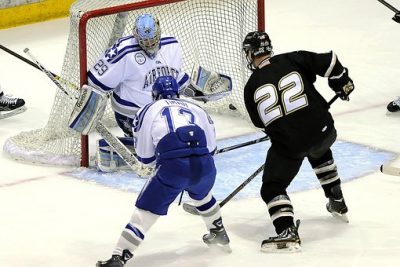
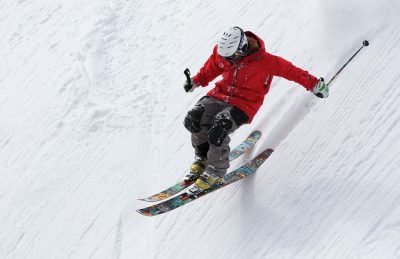

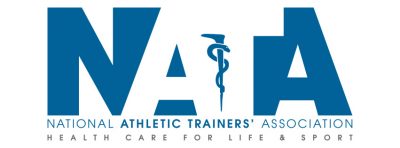
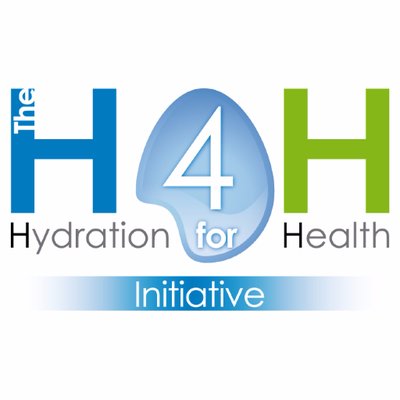


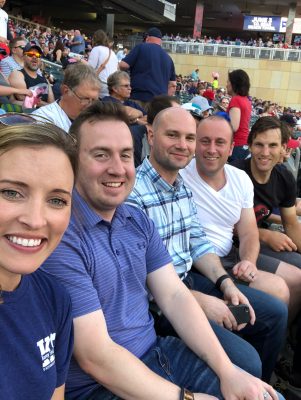 Attending this conference allows the KSI staff to obtain further knowledge, skills and new ideas as well as make new relationships with other professionals. This conference certainly helps to develop KSI and execute our goals to maximize performance, optimize safety and prevent sudden death for the athlete, soldier and laborer. The KSI staff members are thankful to all of the presenters and attendees for their contributions to this field as well as helping make this conference one where individuals who are passionate about similar topics can meet, collaborate, and enjoy one another.
Attending this conference allows the KSI staff to obtain further knowledge, skills and new ideas as well as make new relationships with other professionals. This conference certainly helps to develop KSI and execute our goals to maximize performance, optimize safety and prevent sudden death for the athlete, soldier and laborer. The KSI staff members are thankful to all of the presenters and attendees for their contributions to this field as well as helping make this conference one where individuals who are passionate about similar topics can meet, collaborate, and enjoy one another.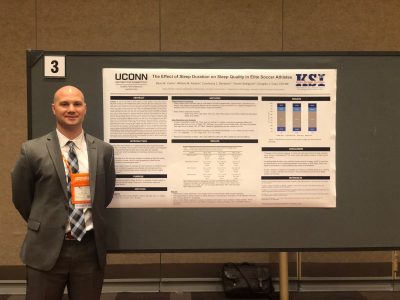
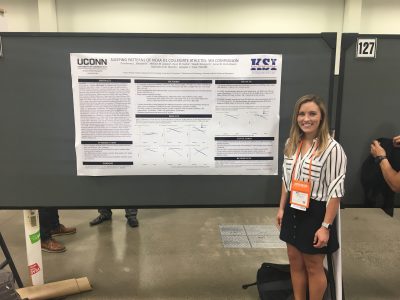
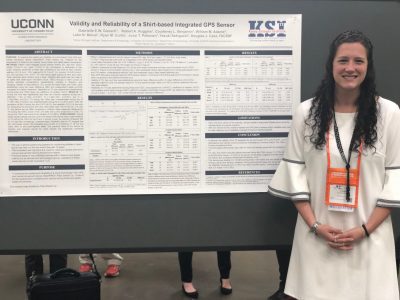


 The week kicked off with our Medical & Science Advisory Board Meeting at one of Dr. Casa’s favorite restaurants – Bubba Gump Shrimp Co. We were very thankful to have so many familiar faces in the room, and even saw a little competitiveness come out in a friendly game of Bubba Gump Trivia. Following dinner and a lot of laughs, Dr. Casa spoke to the Board regarding the recent accomplishments of KSI, especially three primary initiatives that have been the focus over the last couple years: (1) the ‘Raise Your Rank Campaign’, a state-specific approach aimed at improving mandated best practices policies to reduce catastrophic injuries in sport, (2) the Athletic Training Locations and Services (ATLAS) database, which has now officially mapped the extent of athletic trainer services provided to every public and private secondary schoolacross the United States, and (3) the Perceptions of Athletic Training study, which is currently assessing perceptions of the profession from athletic directors, principals, superintendents, legislators, coaches, and parents in order to develop educational strategies to further raise awareness of the value of the athletic training profession.
The week kicked off with our Medical & Science Advisory Board Meeting at one of Dr. Casa’s favorite restaurants – Bubba Gump Shrimp Co. We were very thankful to have so many familiar faces in the room, and even saw a little competitiveness come out in a friendly game of Bubba Gump Trivia. Following dinner and a lot of laughs, Dr. Casa spoke to the Board regarding the recent accomplishments of KSI, especially three primary initiatives that have been the focus over the last couple years: (1) the ‘Raise Your Rank Campaign’, a state-specific approach aimed at improving mandated best practices policies to reduce catastrophic injuries in sport, (2) the Athletic Training Locations and Services (ATLAS) database, which has now officially mapped the extent of athletic trainer services provided to every public and private secondary schoolacross the United States, and (3) the Perceptions of Athletic Training study, which is currently assessing perceptions of the profession from athletic directors, principals, superintendents, legislators, coaches, and parents in order to develop educational strategies to further raise awareness of the value of the athletic training profession.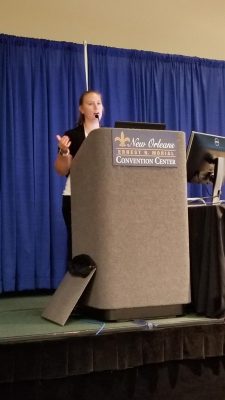
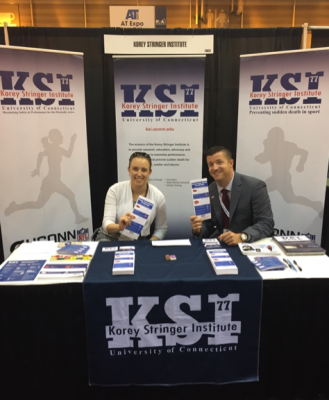
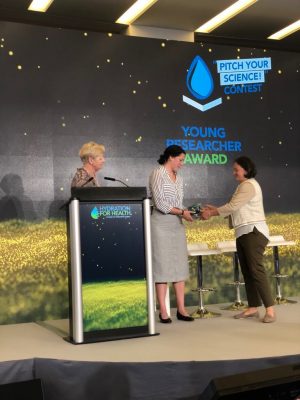
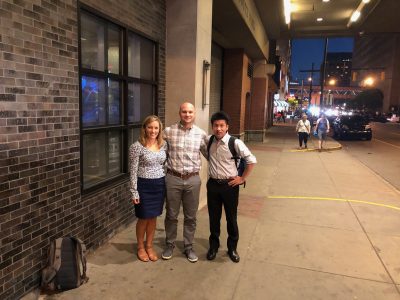

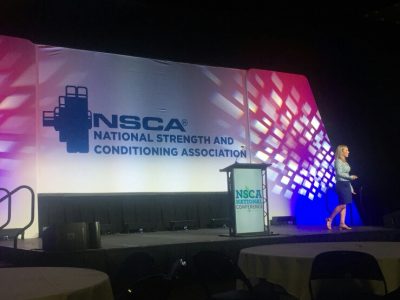
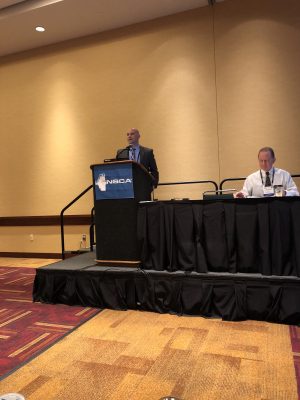

 (May 14th, 2018) — The Korey Stringer Institute (KSI) is proud to honor three individuals for theiroutstanding contributions to preventing sudden death in sport through the KSI’s 2018 lifesaving awards.The awards were presented at NFL headquarters in New York City, NY during the KSI’s annualfundraising gala on May 10, 2018.
(May 14th, 2018) — The Korey Stringer Institute (KSI) is proud to honor three individuals for theiroutstanding contributions to preventing sudden death in sport through the KSI’s 2018 lifesaving awards.The awards were presented at NFL headquarters in New York City, NY during the KSI’s annualfundraising gala on May 10, 2018. KSI Lifesaving Research Award
KSI Lifesaving Research Award KSI Lifesaving Service Award
KSI Lifesaving Service Award KSI Lifesaving Education Award
KSI Lifesaving Education Award